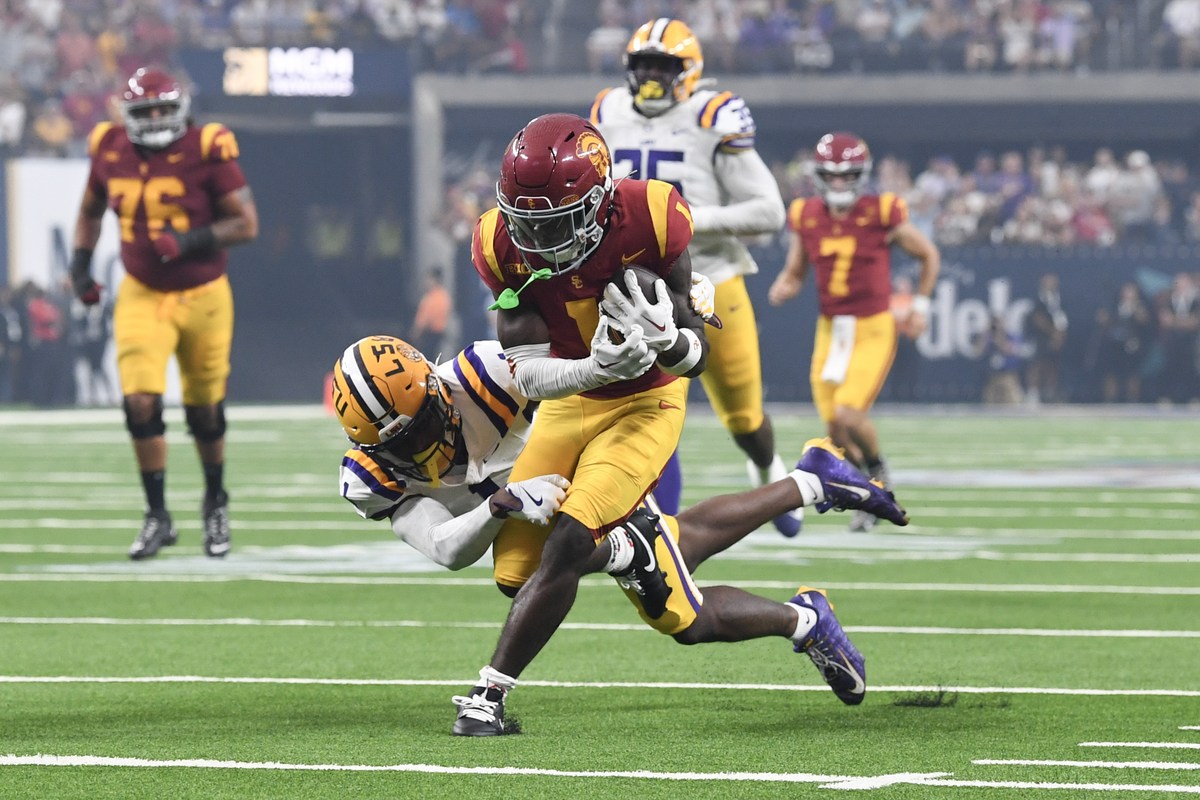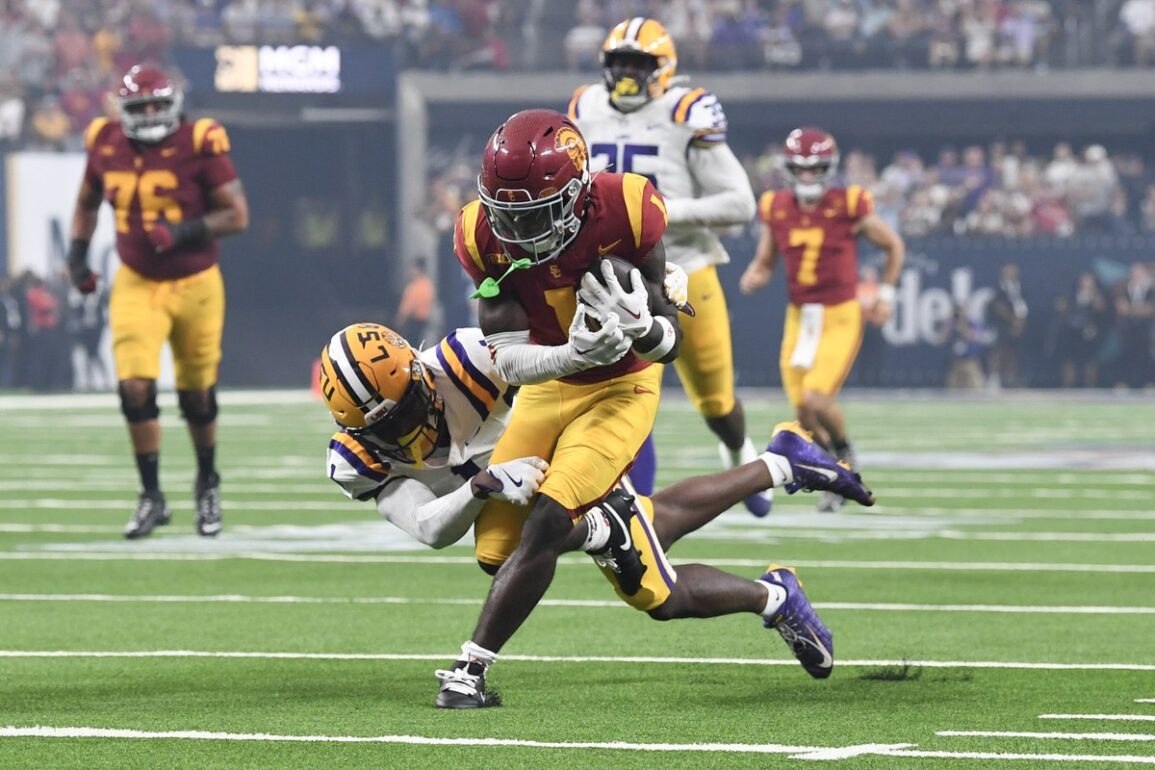
Reports of an expanded playoff conversation driven by the SEC and the Big Ten continue to dominate the offseason conversation, and with it, Ross Dellenger of Yahoo Sports was the first to report the potential expansion once the current playoff format expires after the 2025-2026 season.
In the report, Dellegner also mentions the potential for the SEC to expand to nine conference games, an idea former Alabama head coach Nick Saban initially rebuffed during his time as a coach, but one he supported in his later days of coaching and since joining the media ranks.
With the changes in the SEC schedule, Dellenger also noted potential joint scheduling between the two powerhouse conferences in college football – something that could be both beneficial and detrimental to college football as we know it.
The Good
Marquee matchups are the driving factor of college football and always have been. Primetime matchups between the heaviest hitters, with the best traditions of the sport on display, always generate viewership. Budding rivalries, and the reintroduction of old ones, have allowed the casual fan to enjoy the sport at a similar level to diehard fans.
When No. 2 Georgia traveled to Tuscaloosa to take on No. 4 Alabama, it was the most-watched college football game of the season until Georgia took on another big-name program in Texas. Alabama’s thrilling 41-34 victory over Georgia, capped by freshman Ryan Williams’s alien-like touchdown, garnered an average of 11.99 million views according to Football Scoop.
The Southeastern Conference reported extreme revenue gains in 2023, and while the 2024 numbers are not yet released, we can assume the conference will report similar, if not more revenue, with the addition of Texas and Oklahoma in 2024.
In 2023, the total revenue reported was $790.7 million distributed by the SEC, with $17.7 million awarded to universities that played in bowl games.
According to CBS Sports, the Big Ten reported even bigger revenue gains, with $880 million. The 12 longest-tenured schools received $60.5 million and Rutgers and Maryland (who joined the conference in 2014) received $58.9 million. The Big Ten will almost certainly report more gains in 2024 – potentially hovering over the $1 billion mark with the additions of Oregon, USC, UCLA, and Washington to the conference.
All this to say, the big names generate big money. According to Football Scoop, the SEC and Big Ten combined for 83 of the 98 appearances by the Power Four in the most-watched games of 2024.
The SEC led the way with the top three programs and five out of the top six.
Georgia appeared in 10 of the 50 most-watched games of 2024.
Alabama appeared in eight
Texas appeared in seven
Ohio State appeared in six
LSU and Texas A&M appeared in five
Cross-conference matchups performed well, with Texas-Michigan in week two generating 9.19 million viewers, LSU-USC generating 8.62 million, Clemson-Georgia generating 7.58 million, and Alabama-Wisconsin generating 5.03 million. SEC vs. big-name teams from the other Power Four conferences are the money makers.
The scheduling trend will remain the same in 2025, with captivating matchups already on the schedule for next season.
Alabama will go to Florida State on August 30
Michigan goes to Oklahoma on September 6
Florida goes to Miami on September 20
LSU goes to Clemson on August 30
Texas goes to Ohio State on August 30
Wisconsin goes to Alabama on September 13
Not to mention games within conferences generate viewership as well.
Alabama goes to Georgia on September 27
Alabama goes to South Carolina on October 25
Georgia goes to Tennessee on September 13
Texas goes to Georgia on November 15
Ohio State goes to Michigan on November 29
Oregon goes to Penn State on September 27
And several other enjoyable games outside of the previously listed ones.
Viewership is expected to continue to rise across college football with the captivating matchups, resulting in more entertaining games for college football viewers, and more television revenue for conferences. It could be viewed as a win-win for all parties involved unless you coach or play for the schools.
The Bad
While viewership is good for revenue, the constant travel brought by these matchups is detrimental to player health and safety in addition to academics.
According to Verywell Health, it is recommended to travel one day in advance for each time zone covered to avoid a lack of performance for athletes. A marquee team such as Oregon (Who played in 14 games in the 2024 season) traveled 12,520.26 miles in the 2024 season – fourth most among Big Ten teams according to Sports Illustrated.
The Ducks traveled to California, Indiana, Michigan, Indiana again, and California again for road and neutral site games in 2024. In 2025, Oregon will travel to Illinois, Pennsylvania, New Jersey, Iowa, and Washington in the regular season.
Oregon is one of several teams that will face these tough trips this season. Traveling this much can stunt an athlete’s recovery and school studies. For longer trips, most schools tend to travel on a Thursday, interrupting a tight schedule between practice, class, recovery, and any independent work or study the athletes have.
With expanded scheduling, similar to the ACC-SEC challenge in men’s basketball, it can become troublesome and expensive for teams to travel as extensively as it may require. If the conferences were regionally aligned, like they were before the death of the Pac-12, It would not be as much of an issue. But in a hypothetical Big Ten-SEC challenge in football, SEC teams and Big Ten teams would be traveling across the country.
Using the 2024 SEC and Big Ten standings, let’s take a look at the hypothetical matchups we could get with these games.
Texas would play Oregon, likely in Austin, Texas since the Longhorns traveled to Michigan in 2024. The trip would cost one team over 4,000 miles in roundtrip travel.
Georgia would play Penn State, costing one team over 1,400 miles in roundtrip travel.
The closest trip would be the Tennessee Volunteers taking on the Indiana Hoosiers, still costing either the Vols or the Hoosiers an added 694 miles to travel.
Alabama would play Ohio State in Tuscaloosa, costing the Buckeyes 1,250 miles.
LSU would play Illinois, costing either the Tigers or the Fighting Illini 1,565 miles in extra travel costs.
One option to remedy the extreme travel costs would be neutral site games in NFL stadiums, but this removes the home-field advantage that college football fans love, as well as potentially introducing a conflict with NFL stadiums amid the NFL schedule. The only viable option would be to play the “SEC-Big Ten Challenge” in Week One, which would require a shuffling of several teams’ schedules, including buying out currently scheduled week one opponents for both the SEC and the Big Ten.
Wyatt Fulton is the TIde 100.9 DME and Brand Manager, primarily covering Alabama Crimson Tide football and men’s basketball. For more Crimson Tide coverage, follow Wyatt on X (Formerly known as Twitter) at @FultonW_.
Alabama is Handed Second SEC Loss by Auburn at Home
Gallery Credit: Wyatt Fulton
Hey Dawgs! Tide Hoops Earns Big Win at Home
Gallery Credit: Wyatt Fulton
Alabama Basketball Claws to Victory Over Mississippi State
Gallery Credit: Wyatt Fulton
Gallery: Alabama Basketball Survives Upset Alert by LSU
Gallery Credit: Wyatt Fulton
Alabama’s Bench Leads Tide to Important Win Over Vanderbilt
Gallery Credit: Wyatt Fulton
Ole Miss Hands Alabama its first loss in SEC play
Gallery Credit: Wyatt Fulton
Alabama Claims its First National Championship Under Nick Saban
Gallery Credit: Wyatt Fulton
Alabama is Upset by Michigan in 2024 Reliaquest Bowl
Gallery Credit: Wyatt Fulton
Alabama Thrashes LSU 42-13 in Death Valley
Gallery Credit: Wyatt Fulton
Alabama Claws to Victory Against Arkansas State
Gallery Credit: Wyatt Fulton
This post was originally published on this site be sure to check out more of their content.





